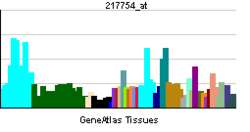- DDX56
-
DEAD (Asp-Glu-Ala-Asp) box polypeptide 56 Identifiers Symbols DDX56; DDX21; DDX26; NOH61 External IDs OMIM: 608023 MGI: 1277172 HomoloGene: 6498 GeneCards: DDX56 Gene EC number 3.6.4.13 Gene Ontology Molecular function • nucleotide binding
• RNA binding
• ATP-dependent RNA helicase activity
• helicase activity
• protein binding
• ATP binding
• hydrolase activity
• identical protein bindingCellular component • nucleus
• nucleolusBiological process • rRNA processing Sources: Amigo / QuickGO RNA expression pattern 
More reference expression data Orthologs Species Human Mouse Entrez 54606 52513 Ensembl ENSG00000136271 ENSMUSG00000004393 UniProt Q9NY93 Q5SVX2 RefSeq (mRNA) NM_019082 NM_026538.3 RefSeq (protein) NP_061955 NP_080814.1 Location (UCSC) Chr 7:
44.61 – 44.61 MbChr 11:
6.16 – 6.17 MbPubMed search [1] [2] Probable ATP-dependent RNA helicase DDX56 is an enzyme that in humans is encoded by the DDX56 gene.[1][2]
This gene encodes a member of the DEAD box protein family. DEAD box proteins, characterized by the conserved motif Asp-Glu-Ala-Asp (DEAD), are putative RNA helicases. They are implicated in a number of cellular processes involving alteration of RNA secondary structure such as translation initiation, nuclear and mitochondrial splicing, and ribosome and spliceosome assembly. Based on their distribution patterns, some members of this family are believed to be involved in embryogenesis, spermatogenesis, and cellular growth and division. The protein encoded by this gene shows ATPase activity in the presence of polynucleotides and associates with nucleoplasmic 65S preribosomal particles. This gene may be involved in ribosome synthesis, most likely during assembly of the large 60S ribosomal subunit.[2]
References
- ^ Zirwes RF, Eilbracht J, Kneissel S, Schmidt-Zachmann MS (Jul 2000). "A Novel Helicase-Type Protein in the Nucleolus: Protein NOH61". Mol Biol Cell 11 (4): 1153–67. PMC 14838. PMID 10749921. http://www.pubmedcentral.nih.gov/articlerender.fcgi?tool=pmcentrez&artid=14838.
- ^ a b "Entrez Gene: DDX56 DEAD (Asp-Glu-Ala-Asp) box polypeptide 56". http://www.ncbi.nlm.nih.gov/sites/entrez?Db=gene&Cmd=ShowDetailView&TermToSearch=54606.
Further reading
- Maruyama K, Sugano S (1994). "Oligo-capping: a simple method to replace the cap structure of eukaryotic mRNAs with oligoribonucleotides". Gene 138 (1–2): 171–4. doi:10.1016/0378-1119(94)90802-8. PMID 8125298.
- Suzuki Y, Yoshitomo-Nakagawa K, Maruyama K et al. (1997). "Construction and characterization of a full length-enriched and a 5'-end-enriched cDNA library". Gene 200 (1–2): 149–56. doi:10.1016/S0378-1119(97)00411-3. PMID 9373149.
- Wiemann S, Weil B, Wellenreuther R et al. (2001). "Toward a Catalog of Human Genes and Proteins: Sequencing and Analysis of 500 Novel Complete Protein Coding Human cDNAs". Genome Res. 11 (3): 422–35. doi:10.1101/gr.GR1547R. PMC 311072. PMID 11230166. http://www.pubmedcentral.nih.gov/articlerender.fcgi?tool=pmcentrez&artid=311072.
- Andersen JS, Lyon CE, Fox AH et al. (2002). "Directed proteomic analysis of the human nucleolus". Curr. Biol. 12 (1): 1–11. doi:10.1016/S0960-9822(01)00650-9. PMID 11790298.
- Valdez BC, Yang H, Hong E, Sequitin AM (2002). "Genomic structure of newly identified paralogue of RNA helicase II/Gu: detection of pseudogenes and multiple alternatively spliced mRNAs". Gene 284 (1–2): 53–61. doi:10.1016/S0378-1119(01)00888-5. PMID 11891046.
- Scherl A, Couté Y, Déon C et al. (2003). "Functional Proteomic Analysis of Human Nucleolus". Mol. Biol. Cell 13 (11): 4100–9. doi:10.1091/mbc.E02-05-0271. PMC 133617. PMID 12429849. http://www.pubmedcentral.nih.gov/articlerender.fcgi?tool=pmcentrez&artid=133617.
- Strausberg RL, Feingold EA, Grouse LH et al. (2003). "Generation and initial analysis of more than 15,000 full-length human and mouse cDNA sequences". Proc. Natl. Acad. Sci. U.S.A. 99 (26): 16899–903. doi:10.1073/pnas.242603899. PMC 139241. PMID 12477932. http://www.pubmedcentral.nih.gov/articlerender.fcgi?tool=pmcentrez&artid=139241.
- Scherer SW, Cheung J, MacDonald JR et al. (2003). "Human Chromosome 7: DNA Sequence and Biology". Science 300 (5620): 767–72. doi:10.1126/science.1083423. PMC 2882961. PMID 12690205. http://www.pubmedcentral.nih.gov/articlerender.fcgi?tool=pmcentrez&artid=2882961.
- Ota T, Suzuki Y, Nishikawa T et al. (2004). "Complete sequencing and characterization of 21,243 full-length human cDNAs". Nat. Genet. 36 (1): 40–5. doi:10.1038/ng1285. PMID 14702039.
- Lehner B, Sanderson CM (2004). "A Protein Interaction Framework for Human mRNA Degradation". Genome Res. 14 (7): 1315–23. doi:10.1101/gr.2122004. PMC 442147. PMID 15231747. http://www.pubmedcentral.nih.gov/articlerender.fcgi?tool=pmcentrez&artid=442147.
- Gerhard DS, Wagner L, Feingold EA et al. (2004). "The Status, Quality, and Expansion of the NIH Full-Length cDNA Project: The Mammalian Gene Collection (MGC)". Genome Res. 14 (10B): 2121–7. doi:10.1101/gr.2596504. PMC 528928. PMID 15489334. http://www.pubmedcentral.nih.gov/articlerender.fcgi?tool=pmcentrez&artid=528928.
- Andersen JS, Lam YW, Leung AK et al. (2005). "Nucleolar proteome dynamics". Nature 433 (7021): 77–83. doi:10.1038/nature03207. PMID 15635413.
- Ewing RM, Chu P, Elisma F et al. (2007). "Large-scale mapping of human protein–protein interactions by mass spectrometry". Mol. Syst. Biol. 3 (1): 89. doi:10.1038/msb4100134. PMC 1847948. PMID 17353931. http://www.pubmedcentral.nih.gov/articlerender.fcgi?tool=pmcentrez&artid=1847948.
Categories:- Human proteins
- Chromosome 7 gene stubs
Wikimedia Foundation. 2010.
